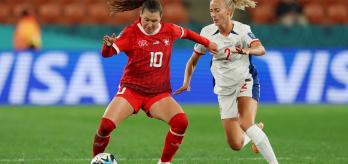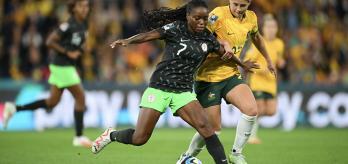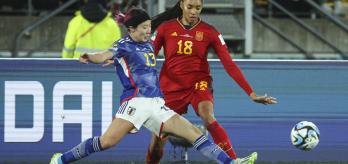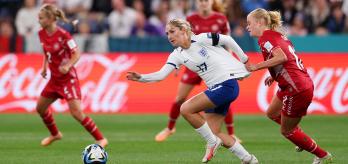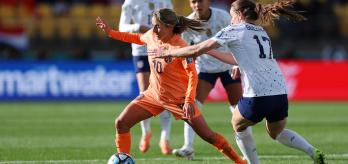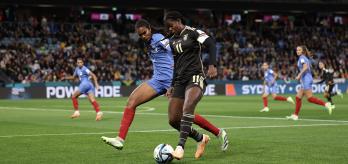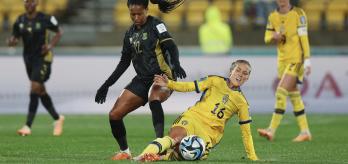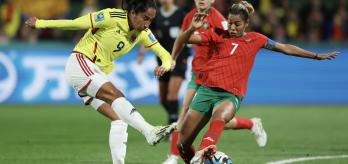With the final rankings undecided until the final whistle of matchday three, Group A proved to be one of the closest of the tournament. Each of the four teams won a game, but ultimately Switzerland finished first and Norway edged out co-hosts New Zealand on goal difference to qualify second. The Football Ferns' historic victory in the opening game against Norway and the Norway's third-round rout of the Philippines are two of several standout moments in this group.
Switzerland
Pascal Zuberbühler: Switzerland play in a 4-3-3 system. Out of possession, they have shown two faces: they can press high or use a midfield pressing system. They are a very compact side. The four defenders play very closely together and they are very, very well connected to their goalkeeper, Gaëlle Thalmann (1). The play of the goalkeeper in possession is very, very good. The players know exactly where they have to go and how Thalmann plays passes, and they can use various variations. The first time they might play through the opposition, the next they might play into the midfield, but they can also play the ball directly into the big Number 9, Ana-Maria Crnogorčević.
In possession, the Swiss always try to do good build-up play, and a lot of it runs via their captain, Lia Wälti (13). She is clearly the key player in the midfield three, playing centrally in front of the defence, and she always has a lot of ball contacts. From there, the ball is quickly played into the top corner of the pitch, to Crnogorčević and to Geraldine Reuteler (6), who plays in the midfield next to her. With her pace, they are able to push the ball forwards for midfield and push on into the top corner of the pitch. At the same time, they have an exception to the rule in Ramona Bachmann (10) too, who is able to score goals and create chances.
The strengths of the Swiss team are clearly compactness and defending their own goal. They kept three clean sheets, and that starts from the front. After a striker has a chance at goal, they immediately return to their position and defend in the 4-3-3 block. They do that excellently. The weaknesses are clearly in attack as they don't get many chances in the attacking zone. They do get their chances in every game, but often the last pass is missing.
In the first game, they won 2-0 against the Philippines, and the other two games were 0-0. That shows, for me, that the Swiss are very dangerous in a tournament and very difficult to win against.
Norway
Kirsty Yallop: Norway generally showed a more direct style of attacking play, looking to play long balls into the striker, who would then try to link play with her two attacking midfielders. When playing through the midfield and central areas, they showed great attacking midfield runs from in to out. Norway were adept at getting players into the channels, causing overloads and exploiting space in behind the full-backs.
This allowed them to get a lot of crosses into the box from different wide areas, as well as from deeper angles. It was in these situations that they looked most dangerous. They attack down both the left and right sides of the field. Caroline Graham Hansen (10) and Guro Reiten (11) were Norway's key players for creating final-third entries. Norway's full-backs were integral to their ability to create space and stretch opposition lines
New Zealand
Kirsty Yallop: New Zealand are very compact and connected in their defensive shape, and look to press mainly from their mid-block. They are patient and press as play moves from the opposition centre-backs to their full-backs. The near-side striker presses and the opposite forward supports them by threatening the opposition centre-back and locking play down one side of the field.
To progress the ball, New Zealand look to play directly into the channels, exploiting space behind the opposition full-backs. The Football Ferns also try to play into the striker as early as possible (specifically Hannah Wilkinson (17)) off the front. They then ask her to secure the ball and link the play, and to continue into the space in the channels. Their play is more dominant down the right-hand side, and they use good combination play and movement to get crosses in from wide areas.
Philippines
Anna Signeul: The Philippines are a well-structured and organised team operating in a mid to low-block when out of possession. They attack and defend as a team, keeping the distances short between the players both when pressing high and counter-attacking. Philippines also demonstrated that they can play quickly through opposition lines up to their hard-working forwards.
Goalkeeper Olivia Davies-McDaniel (1) played with confidence and was great in aerial contests. She made some explosive saves to stop shots and distributed the ball well, both in terms of accuracy and distance. The Filipinas demonstrated key athletic attributes such as power, strength and explosivity, and as a whole the team displayed a strong mentality and work ethic.








